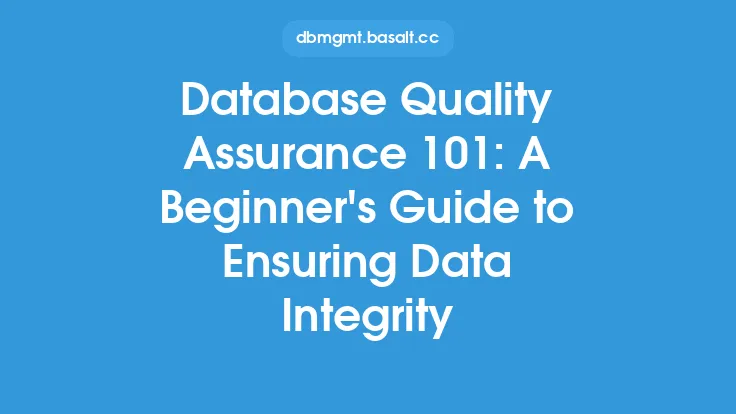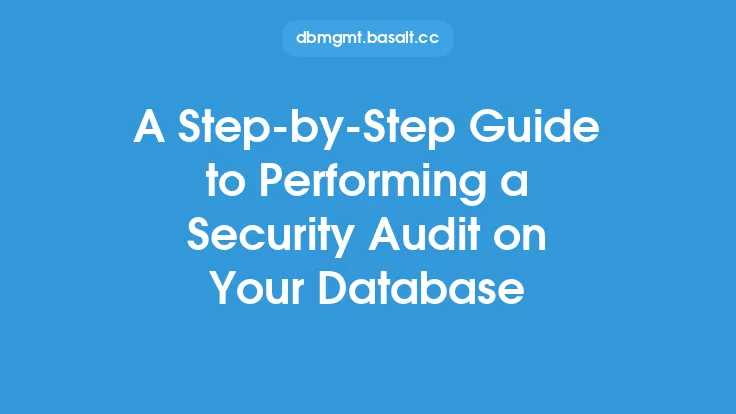Getting started with database testing can seem like a daunting task, especially for those new to the field of database implementation. However, it is a crucial step in ensuring the integrity and reliability of a database. In this article, we will cover the basics of database testing, including its importance, types, and methodologies.
Introduction to Database Testing
Database testing is the process of verifying that a database management system (DBMS) meets the required specifications and functions as expected. It involves checking the database's functionality, performance, and security to ensure that it can store, retrieve, and manage data efficiently and effectively. Database testing is essential to prevent data corruption, errors, and security breaches that can compromise the integrity of the database.
Types of Database Testing
There are several types of database testing, each with its own specific goals and objectives. These include:
- Functional testing: This type of testing verifies that the database functions as expected, including data insertion, update, deletion, and retrieval.
- Performance testing: This type of testing evaluates the database's performance under various loads and stress conditions to ensure that it can handle the required volume of data and user traffic.
- Security testing: This type of testing checks the database's security features, including authentication, authorization, and access control, to prevent unauthorized access and data breaches.
- Recovery testing: This type of testing verifies that the database can recover from failures, such as power outages or system crashes, without losing data or compromising its integrity.
Database Testing Methodologies
There are several database testing methodologies that can be employed, depending on the specific requirements and goals of the testing process. These include:
- Black box testing: This methodology involves testing the database without knowing its internal structure or implementation details. It focuses on the database's functionality and behavior, rather than its internal workings.
- White box testing: This methodology involves testing the database with knowledge of its internal structure and implementation details. It focuses on the database's internal workings, including its algorithms, data structures, and system architecture.
- Gray box testing: This methodology involves testing the database with some knowledge of its internal structure and implementation details. It combines the benefits of black box and white box testing, allowing testers to focus on the database's functionality and internal workings.
Database Testing Techniques
There are several database testing techniques that can be employed to ensure the integrity and reliability of a database. These include:
- Equivalence partitioning: This technique involves dividing the input data into partitions based on its equivalence, and testing each partition to ensure that the database functions correctly.
- Boundary value analysis: This technique involves testing the database with boundary values, such as minimum and maximum values, to ensure that it functions correctly at the boundaries.
- State transition testing: This technique involves testing the database's state transitions, such as from one state to another, to ensure that it functions correctly and consistently.
Database Testing Tools and Technologies
There are several database testing tools and technologies available, each with its own specific features and capabilities. These include:
- Database management systems: These are software systems that manage and control the database, including its creation, modification, and deletion.
- Testing frameworks: These are software frameworks that provide a structured approach to testing, including test automation, test data management, and test reporting.
- Test data management tools: These are software tools that manage and control the test data, including its creation, modification, and deletion.
Best Practices for Database Testing
There are several best practices for database testing that can help ensure the integrity and reliability of a database. These include:
- Develop a comprehensive testing plan: This involves identifying the testing goals and objectives, selecting the testing methodologies and techniques, and creating a testing schedule and budget.
- Use automated testing tools: This involves using software tools to automate the testing process, including test data management, test execution, and test reporting.
- Test for security and compliance: This involves testing the database's security features, including authentication, authorization, and access control, to prevent unauthorized access and data breaches.
Common Database Testing Challenges
There are several common database testing challenges that can arise, including:
- Data complexity: This involves dealing with large and complex datasets, including structured and unstructured data.
- System integration: This involves integrating the database with other systems and applications, including web services, APIs, and messaging systems.
- Performance and scalability: This involves ensuring that the database can handle the required volume of data and user traffic, including high-performance and high-availability requirements.
Conclusion
Database testing is a critical step in ensuring the integrity and reliability of a database. It involves verifying that the database meets the required specifications and functions as expected, including its functionality, performance, and security. By understanding the types, methodologies, and techniques of database testing, testers can ensure that the database is thoroughly tested and validated, and that it can store, retrieve, and manage data efficiently and effectively.





